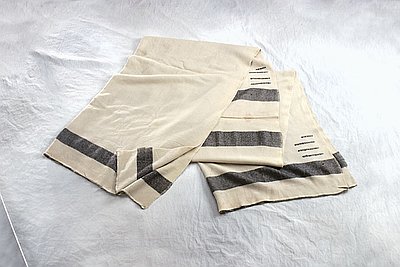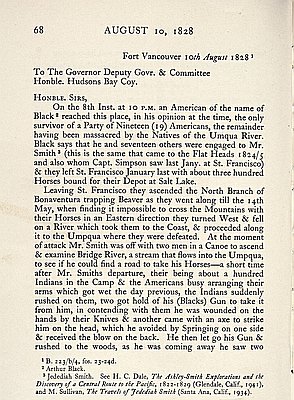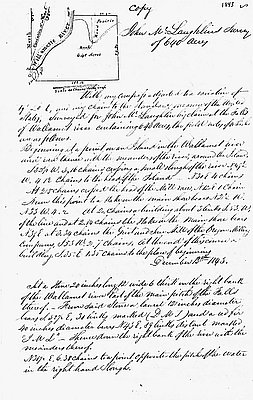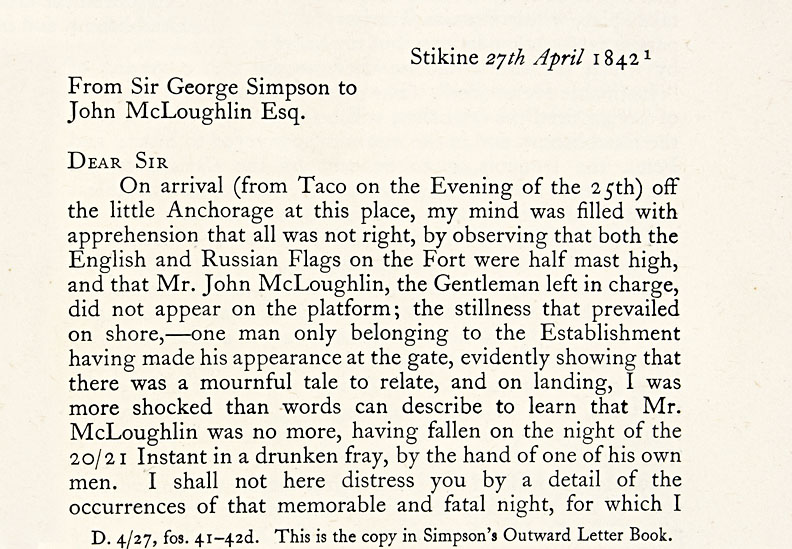- Catalog No. —
- OHS Lib 971 H886 v2
- Date —
- April 27, 1842
- Era —
- 1792-1845 (Early Exploration, Fur Trade, Missionaries, and Settlement)
- Themes —
- Exploration and Explorers, Native Americans, Oregon Trail and Resettlement, Trade, Business, Industry, and the Economy
- Credits —
- Oregon Historical Society
- Regions —
- Columbia River Oregon Country
- Author —
- Governor George Simpson
George Simpson to John McLoughlin, 1842
Hudson’s Bay Company (HBC) Governor George Simpson wrote this short letter to John McLoughlin, chief factor of the company’s Columbia Department, on April 27, 1842, to inform him of the recent murder of his son, John McLoughlin, Jr. “Young John” was chief trader of Fort Stikine, a fur-trading post rented from the Russian American Company on the southeast Alaskan coast. This typescripted version was edited by E. E. Rich and published in 1943 in The Letters of John McLoughlin from Fort Vancouver to the Governor and Committee, Second Series, 1839 – 44
John McLoughlin, Jr. was born on August 18, 1812. For most of his youth, he was raised apart from his father, primarily by his great-uncle, Simon Fraser. Although young John’s first appeal to join the ranks of the HBC was denied (by Simpson himself), his subsequent participation in James Dickson’s failed “Indian Liberating Army” in 1836 gave cause for Simpson to re-evaluate his earlier assessment. Simpson decided to offer young John, along with several other trouble-making “half-breeds” like him, positions in the company rather than have them unemployed and directionless within HBC trading territory. Young John was made chief trader of Fort Stikine during the spring of 1841. He was murdered there in April 1842.
Simpson discovered the death of young John while on a tour of the Columbia Department’s coastal operations. Although his letter to McLoughlin was brief, Simpson’s depiction of the murder as “justifiable homicide” enraged the bereaved father. Simpson’s uncritical and wholesale acceptance of the depositions taken from company employees at Fort Stikine (none of which were cross examined) was completely unacceptable to McLoughlin. Similarly, McLoughlin saw little value in Simpson’s decision to have Urbain Heroux, the suspected murderer, held by the Russian American Company at their fort in New Archangel, rather than have him tried by a British court of law.
Although McLoughlin voiced strong differences of opinion with the upper management of the HBC by 1842, his disapproval of the handling of his son’s murder, his subsequent willingness to ultimately blame Simpson, and his refusal to let matters drop soured relations between him and his employers. In 1846, after acting for nearly twenty years as chief factor of the Columbia Department, McLoughlin was forced to retire from the HBC. Acknowledging the roots of his professional demise, McLoughlin later reflected “Sir George Simpson’s Visit here in 1841 has cost me Dear.”
Further Reading:
Mackie, Richard. Trading Beyond the Mountains: The British Fur Trade on the Pacific, 1793–1843. Vancouver, B.C., 1997.
Morrison, Dorothy Nafus. Outpost: John McLoughlin and the Far Northwest. Portland, Oreg., 1999.
Written by Joshua Binus, Oregon Historical Society, 2006.
Related Historical Records
-
Hudson's Bay Company Blanket
White blankets like this Hudson’s Bay Company (HBC) blanket were among the first to be traded among fur trappers and Native Americans in North America. They were especially …

-
John McLoughlin to Hudson's Bay Co., 1828
John McLoughlin, chief factor of the Hudson’s Bay Company’s Columbia Department, wrote this letter to his superiors on August 10, 1828—two days after Arthur Black, one of four survivors of …

-
McLoughlin Land Survey Claim, 1843
This J. M. Hudspeth survey was carried out at John McLoughlin’s request on December 16, 1843. At the time, McLoughlin was involved in a land dispute with Alvin Waller who …

